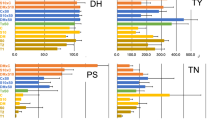Abstract
Six advanced selections of a population of 4x-2x hybrids were tested and compared with six well-adapted Group Tuberosum cultivars under field conditions at four locations in Canada over two years.
Three 4x-2x hybrids produced a total and a marketable yield which was equal to or higher than that of most cultivars over eight environments. For marketable yield considerable differences existed between genotypes in the amount of variation occurring over the eight environments. Both groups of genotypes contained clones with low and high variation for marketable yield.
Analysis of genotype-environment (GE) interactions for marketable yield indicated that all genotypes differed from each other in their responses to the environmental effects. However, there was no clear distinction between the group of 4x-2x hybrids and the group of cultivars for the GE interaction patterns. It appears that the heterosis of the 4x-2x hybrids is the result of a broadening of the genetic base of Group Tuberosum breeding stocks by the incorporation of germ plasm from the primitive diploid South American cultivars. Development of improved diploid parents is necessary in order to achieve the full potential of the 4x-2x hybridization method.
Resumen
Seis selecciones avanzadas de una población de híbridos 4x - 2x se evaluaron y compararon con seis cultivares del Gp. Tuberosum adaptados bajo condiciones de campo durante dos años en cuatro localidades de Canadá.
Tres hibridos 4x - 2x dieron rendimientos totales y comerciales iguales o mayores que la mayoría de los cultivares sobre los ochos ambientes. Se encontraron diferencias genotípicas marcadas para el rendimiento comercial con respecto a la variación ambiental. Ambos grupos de genotipos tuvieron clones con alta y baja variación con respecto a su rendimiento comercial.
El análisis sobre interacción genotipo-ambiente (GE) para el rendimiento comercial indicó que todos los genotipos tienen respuesta diferencial a los efectos ambientales. Sin embargo, no hubo clara distinción entre los híbridos del grupo 4x -2x el grupo de cultivares con respecto a su interacción con el ambiente (GE). Es de esperar que la heterosis de los híbridos 4x -2x sea el resultado de la amplicación de la base genética del Grupo Tuberosum debido a la incorporación de germoplasma proveniente de cultivares primitivos diploides de Sudamérica. Es necesario el mejoramiento de los progenitores diploides para alcanzar el máximo potencial del método de hibridación 4x - 2x.
Similar content being viewed by others
Literature Cited
De Jong, H. and G.C.C. Tai. 1977. Analysis of tetraploid-diploid hybrids in cultivated potatoes. Potato Res 20: 111–121.
Hanneman, R.E., Jr. and S.J. Peloquin. 1969. Use of Phureja and haploids to enhance the yield of cultivated tetraploid potatoes. Am Potato J 46: 436.
Howard, H.W. 1970. Genetics of the potato,Solanum tuberosum. Springer Verlag New York., New York. 126 pp.
Kidane-Mariam, H-M. and S.J. Peloquin. 1975. Method of diplandroid formation and yield of progeny from reciprocal (4x-2x) crosses. J Am Soc Hortic Sci 100(6): 602–603.
MacKenzie, D.R., W.R. Mills and J.O. Watts. 1976. Predicting yield and processing quality of potato breeding selections. Am Potato J 53(3): 87–98.
Mendiburu, A.O. and S.J. Peloquin. 1977. The significance of 2n gametes in potato breeding. Theor Appl Genet 49: 53–61.
Mendiburu, A.O., S.J. Peloquin and D.W.S. Mok. 1974. Potato breeding with haploids and 2n gametes. In: K.J. Kasha (Ed.) Haploids in higher plants. Advances and potential, p. 249–258. University of Guelph, Guelph.
Mok, D.W.S. and S.J. Peloquin. 1975. Breeding value of 2n pollen (diplandroids) in tetraploid × diploid crosses in potatoes. Theor Appl Genet 46: 307–314.
Simmonds, N.W. 1969. Prospects of potato improvement. 48th annual report Scottish plant breeding station, p. 18–38.
Tai, G.C.C. 1971. Genotypic stability analysis and its application to potato regional trials. Crop Sci 11: 184–190.
Tai, G.C.C. 1975. Analysis of genotype-environment interactions based on the method of path coefficient analysis. Can J Genet Cytol 17: 141–149.
Tai, G.C.C. 1979. Analysis of genotype-environment interactions of potato yield. Crop Sci 19: 434–438.
Tai, G.C.C. and D.A. Young. 1972. Genotypic analysis of eight potato varieties tested in a series of ten trials. Am Potato J 49(4): 138–150.
Author information
Authors and Affiliations
Rights and permissions
About this article
Cite this article
De Jong, H., Tai, G.C.C., Russell, W.A. et al. Yield potential and genotype-environment interactions of tetraploid-diploid (4x-2x) potato hybrids. American Potato Journal 58, 191–199 (1981). https://doi.org/10.1007/BF02854419
Received:
Issue Date:
DOI: https://doi.org/10.1007/BF02854419




